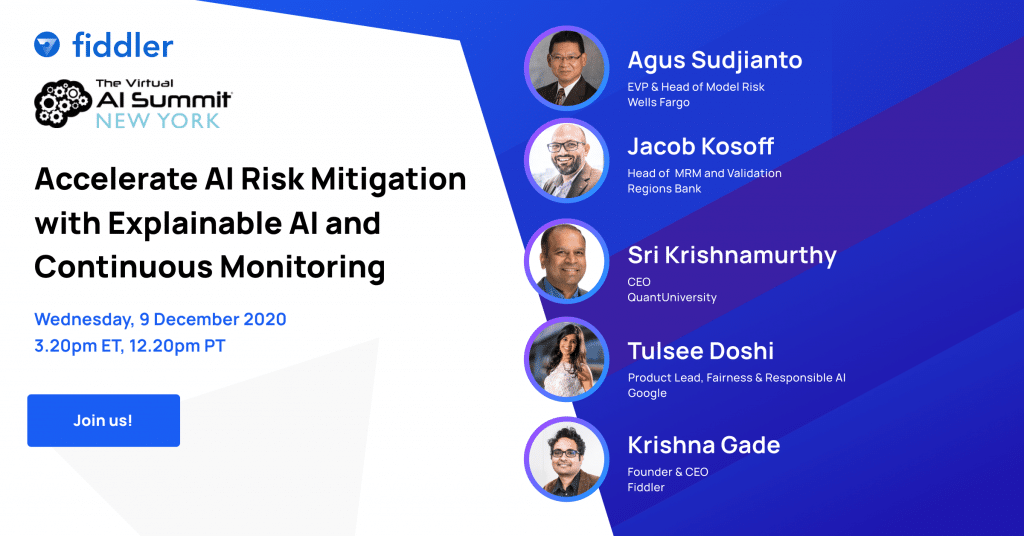 On the AI in Finance Summit, NY, in December 2020, we had a panel dialogue on the state of accountable AI with a bunch of mannequin danger specialists from the monetary companies and tech industries. Beneath is a abstract of the dialogue. You possibly can watch the total panel dialogue right here.
On the AI in Finance Summit, NY, in December 2020, we had a panel dialogue on the state of accountable AI with a bunch of mannequin danger specialists from the monetary companies and tech industries. Beneath is a abstract of the dialogue. You possibly can watch the total panel dialogue right here.
Panel Dialogue: Accelerating AI Threat Mitigation with XAI & Steady Monitoring
How is AI in Finance altering the normal observe of mannequin danger administration?
Mannequin danger administration (MRM) is a well-established observe in banking, however one which can be rising and altering quickly attributable to developments in AI. “We run banks with fashions,” stated Agus Sudjianto (EVP & Head of Mannequin Threat, Wells Fargo)—a press release echoed by Jacob Kosoff (Head of MRM & Validation, Areas Financial institution), who added that 30% of his workforce’s fashions at the moment are machine studying fashions as an alternative of conventional statistical approaches. Improvements from Silicon Valley, similar to TensorFlow, PyTorch, and different frameworks which can be predominately for deep studying, have made their method to Wall Avenue, accelerating the adoption of AI in Finance.
The aim of MRM, additionally referred to as mannequin security, is to keep away from the kind of monetary and reputational hurt that fashions could cause when they’re inevitably incorrect. Machine studying fashions pose new challenges: they’re inherently very complicated, and even when points are caught earlier than the mannequin is deployed, adjustments within the underlying information can utterly alter the mannequin’s habits.
MRM groups have to answer these new necessities and change into thought leaders in the way to construct reliable AI techniques in finance. At banks, “it’s not solely upskilling the quants, who’ve historically been utilizing statistical fashions,” stated Sri Krishnamurthy (CEO, QuantUniversity). “They’ve to consider the entire workflow from growth to manufacturing and construct out completely different frameworks.” Silicon Valley is approaching these issues from a holistic viewpoint as effectively. Tulsee Doshi (Product Lead, Equity & Accountable AI, Google) defined that accountable AI rules overlaying all the pieces from scientific excellence to equity, privateness, and safety are constructed into Google’s launch overview course of, and more and more must be utilized to each stage of product growth.
What are some methods to implement accountable AI in Finance at present?
The panelists shared some approaches they use to institute checks and balances into the mannequin growth course of. At Google, Doshi stated, context is all the pieces: “How a mannequin is deployed in a specific product, who these customers are, and the way they’re utilizing that mannequin is a very vital a part of the chance administration course of.” For example, Doshi defined that an ML know-how like text-to-speech can have some optimistic purposes, significantly for accessibility, but additionally the potential for actual hurt. As an alternative of open sourcing a text-to-speech mannequin that could possibly be used broadly for any use case, “we wish to understand the place the context is smart and prioritize these use circumstances.” Then, the workforce will design metrics which can be acceptable for these use circumstances.
Banks expertise excessive dangers and strict regulatory tips, and it’s essential to have the precise guardrails in place. “Prior to now, the main focus of knowledge scientists was mannequin efficiency and AutoML…for us, it’s very harmful to deal with that,” Sudjianto stated. At Wells Fargo, “for each 3 mannequin builders, we’ve 1 unbiased mannequin evaluator” reporting to completely different components of the organizational chain with the intention to keep away from conflicts of curiosity. After articulating the use for the mannequin, what can go incorrect, and the urge for food for danger, the workforce will consider all of the potential root causes for a incorrect prediction, from the information, to the modeling framework, to coaching. “That’s why interpretability is so vital,” stated Sudjianto.
To implement AI responsibly at a monetary establishment, having the precise tradition is crucial. The MRM workforce must be “keen to problem authority, keen to problem executives, keen to say ‘your mannequin is incorrect,’” Kosoff stated. And from the top-down, everybody on the firm should perceive that “this isn’t a compliance train, this isn’t a regulatory train”—and really, MRM is vital to defending worth.
As Krishnamurthy defined, typically the cultural change additionally means recognizing that “it’s not all about know-how.” Specializing in having the newest, most refined instruments for deep studying techniques may be harmful for establishments simply beginning to transfer off extra conventional statistical fashions: “You’ll discover ways to use the software, however you received’t have the conceptual grounding.” As an alternative, groups may have to take a step again, clearly outline their objectives for his or her fashions, and decide whether or not they have the required data to make use of a black field ML system safely.
How do groups fight algorithmic bias?
Banks are accustomed to combating bias with the intention to set up truthful lending practices—however as monetary establishments implement extra AI techniques throughout the board, they’re confronting new sorts of algorithmic bias. These are the situations that preserve our panelists up at evening, anxious a couple of mannequin’s mistake inflicting information retailers and authorities companies to return knocking.
For instance, as Sudjianto famous, there may be advertising fashions that appear very harmless however truly contact on points with privateness and discrimination which can be closely regulated; NLP can be a serious landmine (“language by nature could be very discriminatory”). Kosoff and Krishnamurthy gave a couple of extra examples of potential bias, like fraud detection being extra prone to flag transactions in sure zip codes, or minority clients getting a special automated name middle expertise.
To fight bias, groups want to contemplate a variety of things earlier than launch, such because the mannequin’s use circumstances, limitations, information, efficiency, and equity metrics. Google makes use of “mannequin playing cards” to seize all this info. “It forces you to doc and report on what you’re doing, which helps any downstream workforce that may choose up that mannequin and use it both externally or internally,” Doshi stated. However even the most effective practices previous to launch can’t forestall the chance of some unexpected change within the manufacturing setting. “We don’t know what errors we’ll see that we didn’t take into consideration or didn’t have the metrics for,” Doshi stated.
That is the place steady monitoring is available in. Kosoff shared an instance of how monitoring has been particularly vital throughout the COVID-19 disaster. “For fraud on a transaction for debit playing cards or bank cards, essentially the most predictive variable is card current or card not current”—however throughout February and March of 2020, instantly ML techniques have been detecting excessive quantities of fraud as clients switched to doing most or all of their procuring on-line.
What adjustments can we count on in 3-5 years?
Within the subsequent 3-5 years, we’re undoubtedly going to see an explosion of more and more complicated modeling methods—which is able to, in flip, put extra stress on monitoring and validation. So what adjustments can we count on from the accountable AI area within the close to future?
Doshi famous that with whitepapers coming from the EU and motion from the US, Singapore, and different governments, “we’re going to see increasingly more regulation come out round truly placing in correct processes round explainability and interpretability.” There most definitely may even be a shift in pc science schooling, in order that college students will graduate with coaching in mannequin danger administration and explainability.
Kosoff can think about a future the place there’s a type of “driver’s license” that certifies that somebody understands the dangers effectively sufficient with the intention to construct fashions. As a step on this path, Areas Financial institution is exploring the thought of getting all new mannequin developer hires spend their first 6 months embedded on the mannequin danger workforce. Upon becoming a member of their everlasting groups, “they’ll be extra skilled, extra certified, they’ll know extra elements of the financial institution, they usually’ll have a robust understanding of equity and all the pieces we’ve talked about on mannequin danger and mannequin analysis.”
Krishnamurthy identified that presently only a few fashions are literally making it out of the exploration part—however within the subsequent few years, “the manufacturing story goes to begin getting consolidated.” Krishnamurthy additionally believes that “among the noise goes to subside”: the preliminary method to throw deep studying fashions at all the pieces will probably be changed by a extra sober understanding of the constraints. Lastly, persevering with a development that started with 2020’s stay-at-home orders, cloud instruments for ML will change into extra distinguished.
In Sudjianto’s opinion, testing remains to be one of many greatest gaps: “Folks speak about counterfactual testing, robustness testing—it’s nonetheless within the tutorial world…in the true world, it’s not scalable.” Establishments want to coach people to be the equal of reliability and security engineers for ML, they usually additionally want the instruments to function at velocity and scale and detect failures forward of time. As Sudjianto stated, “Monitoring can’t be passive anymore.”
 Panelist overview
Panelist overview
Panelists:
Agus Sudjianto, EVP & Head of Mannequin Threat, Wells Fargo
Jacob Kosoff, Head of MRM & Validation, Areas Financial institution
Sri Krishnamurthy, CEO, QuantUniversity
Tulsee Doshi, Product Lead, Equity & Accountable AI
Krishna Gade, Founder & CEO, Fiddler
Associated posts:
Supporting Accountable AI in Monetary Providers
Attaining Accountable AI in Finance
P.S. We constructed Fiddler to fill in these tooling gaps and assist groups construct belief into AI. Groups can simply import their fashions and information units to Fiddler and have steady monitoring and explanations for his or her fashions, making a system of report for ML in manufacturing. Because the accountable AI area continues to evolve, we’re very excited to share extra on this matter. Should you’re occupied with seeing what Fiddler can do, contact us to speak to a Fiddler knowledgeable!
